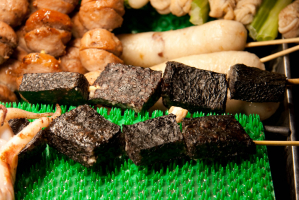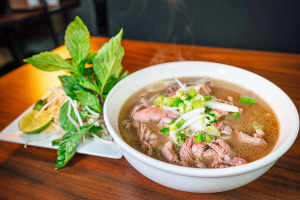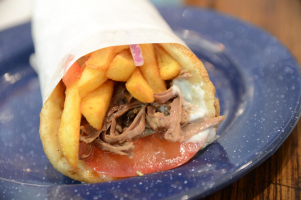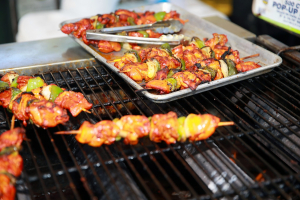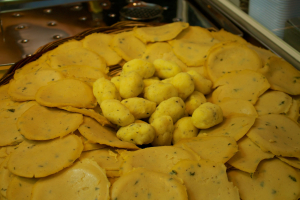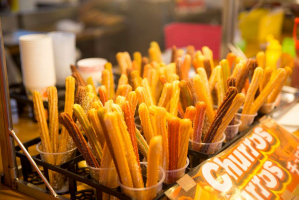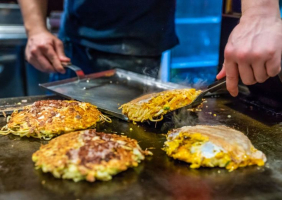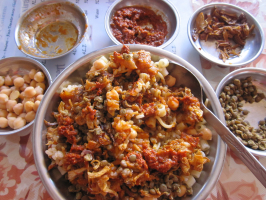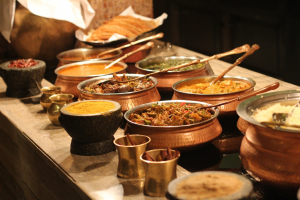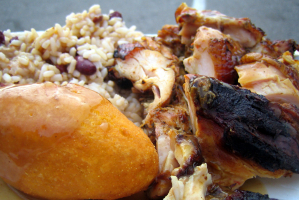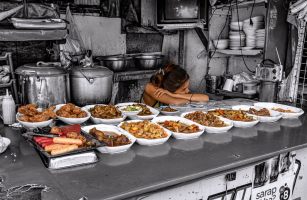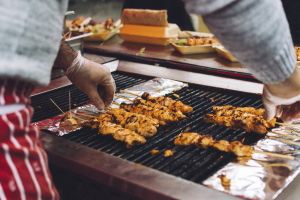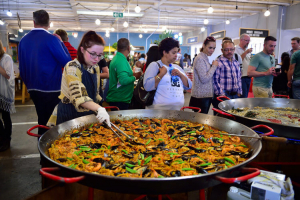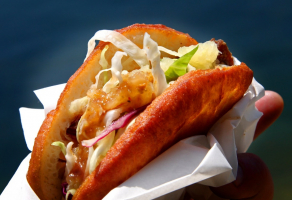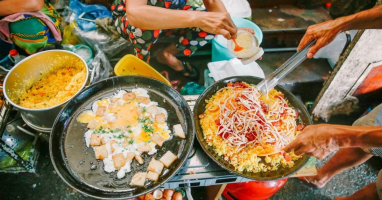Top 10 Most Popular Singaporean Street Foods
The cultures, customs, and cuisines of Southeast Asia are mixed together in Singapore. Notably, Singapore is among the select few nations worldwide whose ... read more...street food has been consistently featured in the Michelin Guide. Read this article until the end to find out which are the most popular Singaporean street foods.
-
Char Kway Teow is the first name to appear on the list of the most popular Singaporean street foods. It is a favorite dish of Singaporeans with a spicy flavor that is very suitable for cool and rainy days. This dish is often sold on food streets and other restaurants and eateries in the "Lion Island".
Originally prepared by farmers and fishermen using leftover materials, char kway teow was a cuisine for the underprivileged. They started selling it on the street after realizing how wonderful this combination was, and it gained popularity very fast.
Typically, ingredients for char kway teow include egg, cockles, bean sprouts, chives, shrimp, and Chinese sausage. Every component is deep-fried and covered in soy sauce; however, certain variations additionally include fried pork fat, garlic, shrimp paste, and perhaps even yellow wheat noodles. The blend of these many flavors has created an unforgettable, rich dish of Singaporean cuisine.
In recent years, Char Kway Teow has been improved in a healthier direction as chefs add more green vegetables and reduce fat. Not only does this make the dish healthier, but the greens and sprouts also give it a fresh and crunchy taste, increasing the quality of this ancient favorite. Char Kway Teow usually has a lot of oil, so you should eat it with more green vegetables to balance it. If you want to "eat hearty" then order more seafood to eat with it!
Every time you pass by a noodle shop, the sound of the pan crackling as the fat boils and the aroma emanating from the dish will stimulate all of the diners' senses, from sight to smell and hearing, and everything in between. That can happen even before visitors actually taste the dish.
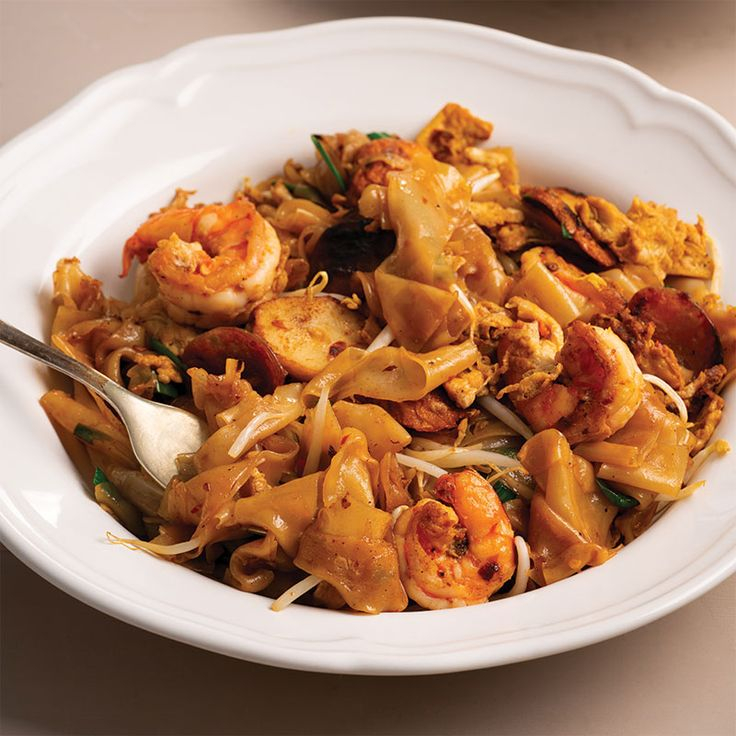
Screenshot of https://www.pinterest.com/pin/842525042812080780/ Video by The Meatmen Channel -
The simple Hainanese chicken rice, first created on the tropical island of Hainan, south of China, has become one of Singapore's most well-known meals. It is made up of bite-sized morsels of cooked chicken that are served over aromatic white rice.
In Singapore, the modern nature of this country's society makes it no longer feasible to store chicken broth so the chicken is boiled in ginger and garlic water, and the chicken broth is used to prepare rice and chicken. soup to serve with. Another version of chicken rice in Singapore uses chicken that has had all its bones removed.
In addition to crushed ginger and chili sauce, Hainanese chicken rice is frequently served with oyster sauce in Singapore. Due to the influence of Southeast Asian cuisine, Hainanese chicken rice is frequently prepared hotter in Singapore. Cucumber is typically served with chicken rice meals to enhance the dish's flavor.
Hainanese chicken rice is considered the national dish of Singapore. It is not only served on the streets but also at international exhibitions, conferences, and Singaporean eateries abroad. One of the Singaporean dishes offered on Singapore Airlines flights is Hainanese chicken rice.
You can cook this dish for your family with the recipe below:
- Step 1: To prepare the chicken, trim off as much fat and extra skin as you can. Save the trimmings of skin and excess fat for later. Season the chicken all over with a generous pinch of salt.
- Step 2: Cut off the dark green tops from six spring onions, reserving white and pale green portions for the spring onion and ginger sauce. Add chicken, stock, ginger, and dark green tops to a stock pot, and simmer gently for 40-60 minutes until cooked.
- Step 3: Prepare the spring onion and ginger sauce by finely slicing it, adding more as needed, and smashing it into a paste. Heat vegetable and sesame oils, pour the hot mixture over the spring onion mixture, mix well, and reserve until ready to serve.
- Step 4: In a saucepan, cook chicken trimmings over medium-high heat until golden brown. Remove and discard the fat. Add garlic and cook until golden. Add rice, cover with chicken stock, and cook for ten minutes. Cover, let sit, and fluff up before serving. Enjoy the tender, firm rice with a fork.
- Step 5: Cut chicken into slices, remove wings, legs, and breasts, brush with sesame oil, and slice meat.
- Step 6: Along with rice, sambal oelek, cucumber, spring onion, ginger sauce, and a small bowl of chicken cooking broth, serve the chicken meat. Just before serving, drizzle some sweet soy sauce over the chicken meat.
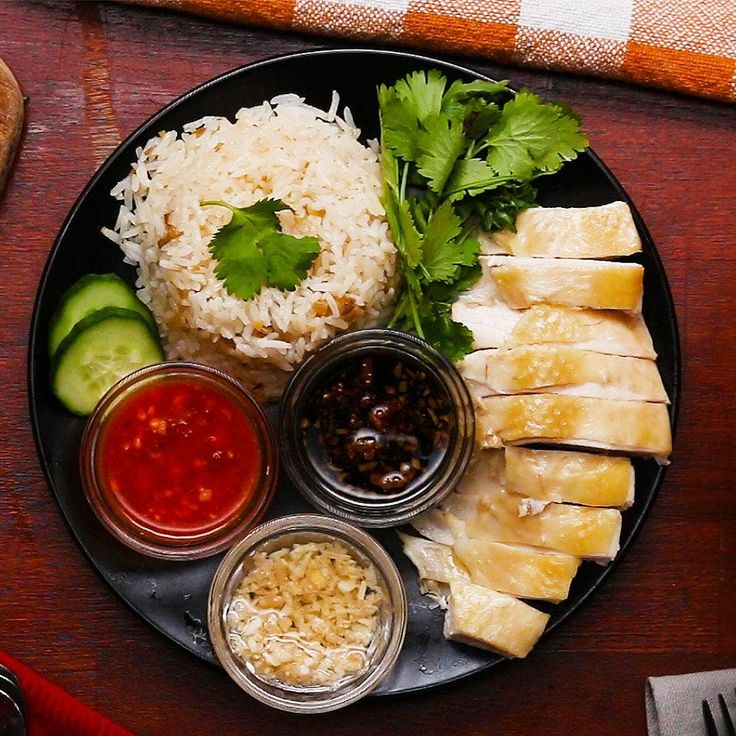
Screenshot of https://www.pinterest.com/pin/10414642879453869/ Video by Andy Cooks -
A common Southeast Asian seafood dish that is connected to both Malaysian and Singaporean cuisines is chilli crab. Often used, mud crabs are stir-fried in a sauce made primarily of tomatoes and chilies that are semi-thick, sweet, and savory.
A well-known anecdote about the invention of chilli crab dates back to the 1950s when Cher Yam Tian wanted to add bottled chili sauce to her stir-fried crab recipe. The outcome was so good that her family convinced her to sell the dish, and thus Singapore's signature dish, chilli crab, was born.
The preparation of chilli crab involves stir-frying the crab in a fragrant blend of garlic, ginger, and shallots, enhancing the dish's aroma. The sauce is the star of the show, crafted with a perfect balance of sweet, sour, and spicy elements. It combines ingredients like tomato sauce, chili paste, soy sauce, and a touch of sugar to achieve that harmonious blend of flavors.
The result is a plate of goodness that brings together the sweetness of the crab meat with the kick of the chili sauce. The vibrant red color of the sauce adds to the visual appeal, making it an appetizing dish to dive into. For the ultimate experience, chilli crab is typically enjoyed with a side of mantou, a soft and fluffy Chinese bun. The mantou is perfect for soaking up the delicious sauce, adding a lovely textural contrast to the tender crab.
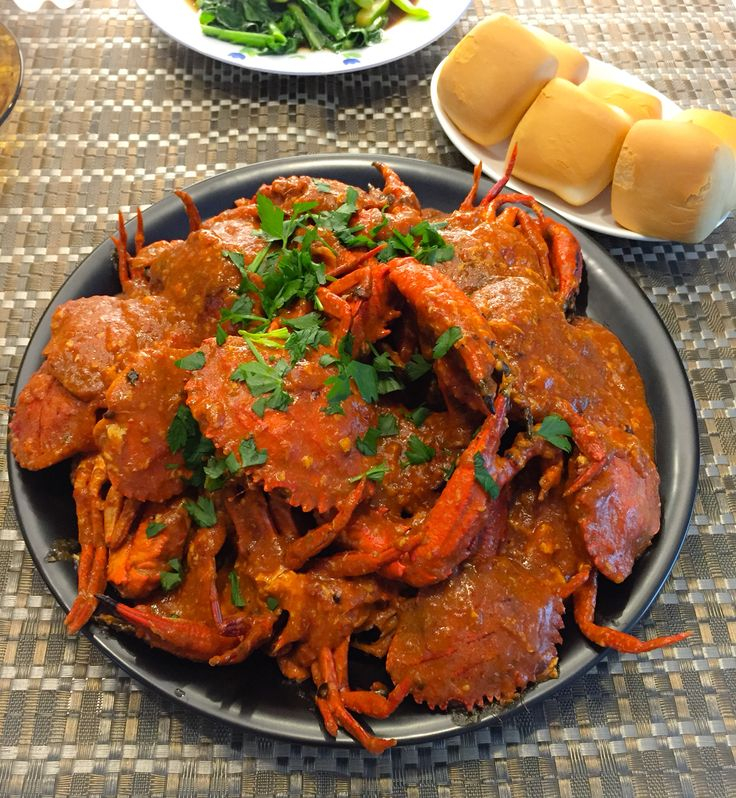
Screenshot of https://www.pinterest.com/pin/253679391503682290/ 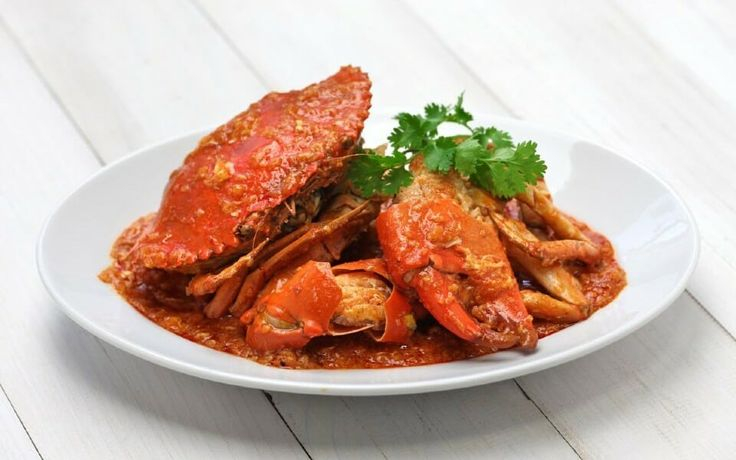
Screenshot of https://www.pinterest.com/pin/689824867951210832/ -
Curry laksa is one of the most popular Singaporean street foods that is sure to tantalize your taste buds. It is a delicious and spicy noodle soup that is packed with exotic flavors and textures.
The broth is rich and creamy, flavored with a blend of aromatic spices, coconut milk, and curry paste. This creates a mouthwatering base that is then filled with a variety of ingredients such as fresh noodles, tender chicken or shrimp, tofu, and an assortment of vegetables.
The rich and creamy curry broth is the star of the show. It is made by simmering a fragrant paste of spices such as lemongrass, galangal, chilies, shallots, and turmeric, in coconut milk. The result is a velvety smooth and spicy broth that is bursting with flavor.
Curry laksa is often garnished with a generous amount of fresh coriander leaves, fried shallots, and a squeeze of lime to enhance the taste and add a zesty freshness to the dish.
If you haven't had the opportunity to go to Singapore to enjoy this dish, please save the curry laksa street food recipe to make at home.
- Step 1: In a saucepan, heat the oil over medium-high heat. Stir in the curry paste and cook for 30 seconds or until aromatic. Add the curry powder and stir. After that, add the chicken and stir-fry it for about one minute. Pour in the chicken stock and coconut milk. Simmer for five minutes.
- Step 2: Add the tofu puffs, prawns, and fish balls (if using) at this point. Simmer until the prawns are cooked, a few more minutes may be needed.
- Step 3: Mix in the sugar and fish sauce, adding more seasoning to taste if necessary. Spoon the noodles with your laksa and garnish with the egg, coriander leaves, and bean shoots.
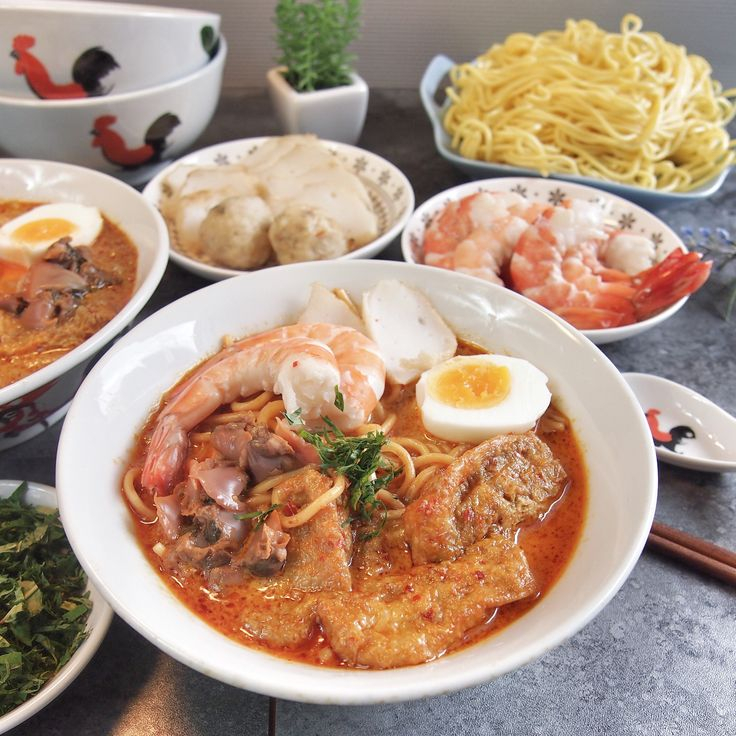
Screenshot of https://www.pinterest.com/pin/240942648800860003/ 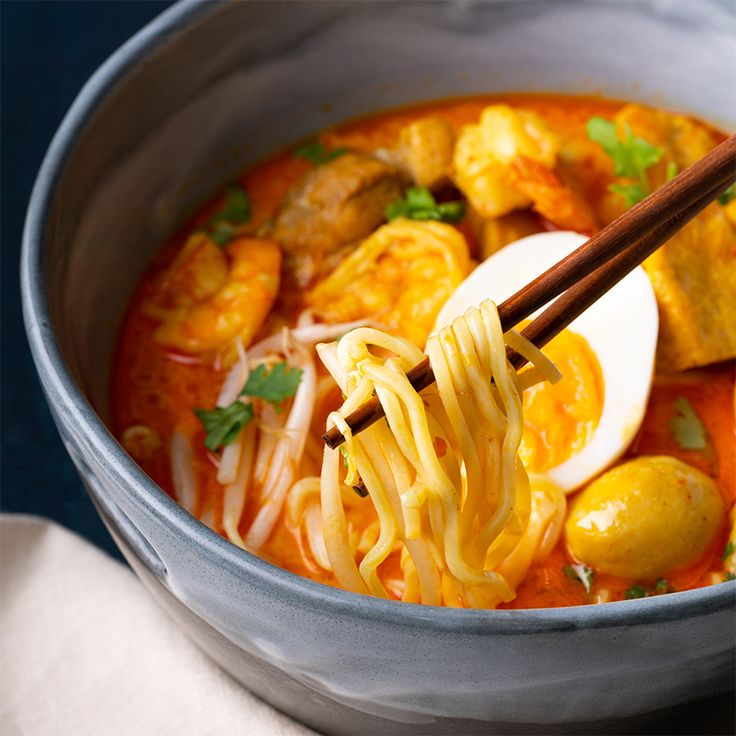
Screenshot of https://www.pinterest.com/pin/123637952263592430/ -
Roti prata is the best street food in Singapore, especially used for breakfast. This famous cake originates from the ancient way of making crepes of Indians and Pakistanis. Roti prata is soft and spongy and has a very characteristic light aroma and sweet taste. When I eat, I feel very delicious and feel more excited and excited. Therefore, this type of cake is often eaten in the morning, helping you have a more enthusiastic and passionate working day.
The ingredients and how to make this cake are not complicated at all. You just need a layer of flour on a wide pan, and put cold meat, butter, cheese, jam, or fillings depending on your preference.Place it on a plate and serve after that. Even the recipe is simple, so you can try making it at home, but to get the best taste, you should eat it at stores in Singapore.
The most difficult part of making Roti prata is kneading the dough so that when eating, you can feel the craftsmanship in the crust and from there determine the eye-catching appearance of the cake. This step requires workers to meticulously rotate and twist the dough until it becomes paper-thin and bulges larger than the original dough block.
The image of the Roti prata maker is also worth seeing. The hands that quickly toss the cake in the air, smash, and flip the cake regularly like squeezing a lemon will definitely make you admire it. Then the worker folds this thin piece of dough into a rectangle and fries it.
At each store, there are variations to create uniqueness for their Roti prata cake, such as adding chocolate, cream, sprinkling sugar, and eggs... To be in the right style, visitors should wash their hands and pick up the cake themselves. Eat instead of using a knife or fork. Dip in the delicious, rich curry sauce to experience all the wonderful flavors of this dish. Guests can also sip an extra glass of wine to avoid getting bored.
Roti prata can be found anywhere in Singapore and visitors will probably find a prata restaurant just a few steps from the hotel.
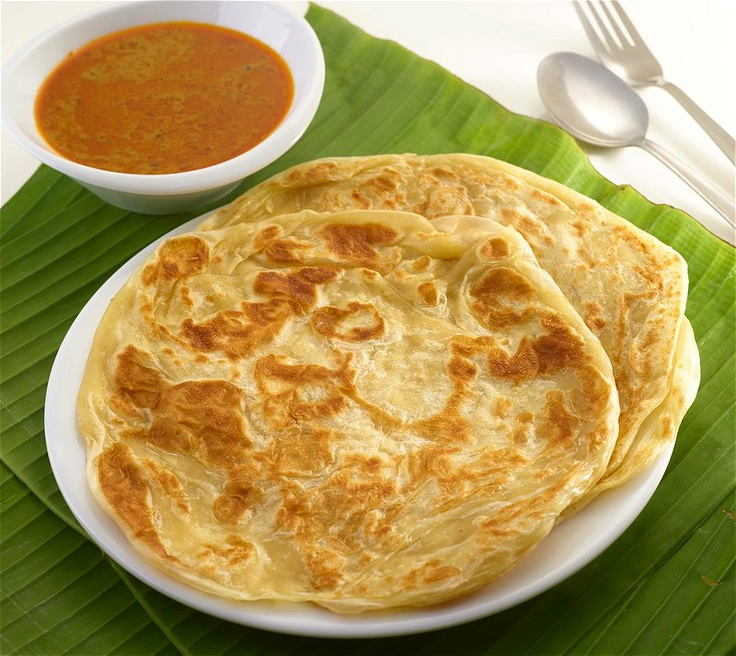
Screenshot of https://www.pinterest.com/pin/334251603569663362/ Video by Workforce Singapore -
A dish called Hokkien mee consists of rice and egg noodles that have been stir-fried with squid, prawns, and pork slices. Large amounts of a fragrant broth made from prawns and pork bones that are slowly simmered for many hours are essential to the recipe.
The diner can mix in the sambal chilli and calamansi limes that are served on the side to give it an extra zest and tang. The dish's aroma is enhanced by the addition of tiny cubes of fried lard and, in some cases, serving it on an opeh leaf, or soft areca palm bark.
Although pork and chicken are the two main traditional meats used in this dish, for health reasons for users, the chef can change the ingredients but still ensure the taste. delicious as well as the nutrients of dishes such as cuttlefish and bacon.
After World War II, Chinese sailors from the southern Chinese province of Fujian (Hokkien) invented the Singaporean version of Hokkien mee. They would gather along Rochor Road after work to cook leftover noodles from the noodle factories over a charcoal stove. This dish is regarded as a classic of Singaporean cuisine, and the Michelin Guide has recognized several hawker stalls that serve it.
To have an attractive Hokkien mee in Singaporean style, you can follow the steps below:
- Step 1: To prepare the prawns and squid, poach them in stock until they are cooked through and then set them aside.
- Step 2: Cut the fish cake into slices and trim the ends to a length of 3 cm.
- Step 3: Render the pork fat down into the oil in a frying pan until the lard becomes crispy.
- Step 4: Pour oil into a wok that fits your size, then stir-fry four beaten eggs until they are cooked.
- Step 5: Fry some more after adding the minced garlic, all of the noodles, and all of the sauces.
- Step 6: Add the bean sprouts and two cups of stock. Cook the noodles until they are tender.
- Step 7: Add the prawns, squid, and the lard turns crispy. If you would like more gravy, feel free to add extra seafood stock.
- Step 8: Garnish with parsley and present alongside calamansi and belachan limes.
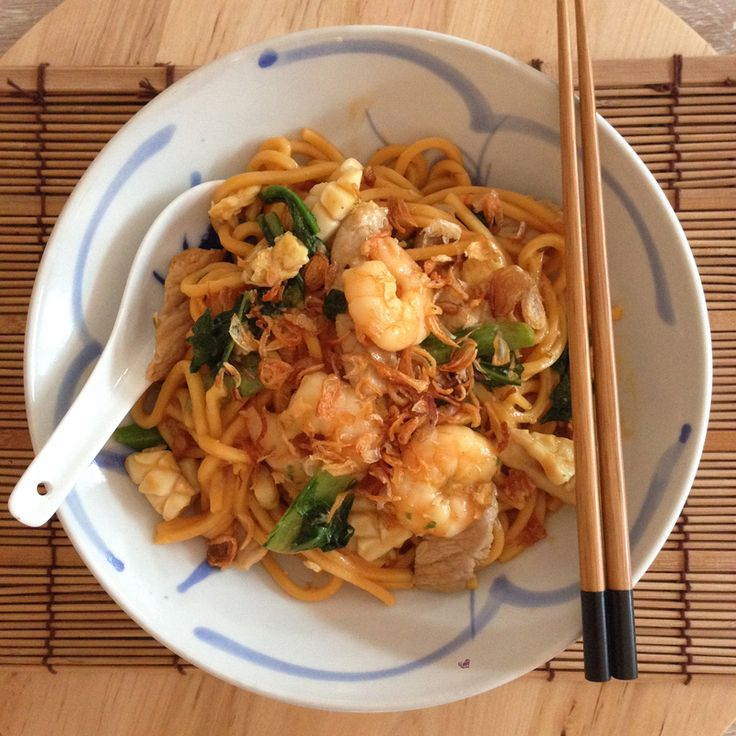
Screenshot of https://www.pinterest.com/pin/334814553543619525/ Video by The Meatmen Channel -
The next name on the list of the most popular Singaporean street foods is fish head curry. This dish is a cross between Chinese and Indian ethnic cuisines. Okra and eggplants are among the various vegetables stewed in a curry along with the head of a red snapper. It is typically served as a shared dish or with bread or rice. In 1949, Gomez Curry, a Singaporean restaurant, served the dish for the first time.
Traditionally, fish head curry is made by simmering the fish head in a flavorful broth made with a blend of spices, onions, tomatoes, and tamarind. The fish head absorbs all the delightful flavors of the curry, resulting in a melt-in-your-mouth experience with every bite. The dish is further enhanced with the addition of vegetables such as eggplant, okra, and bell peppers, which add a wonderful depth and crunch to the curry.
Fish Head Curry is the perfect balance of spicy, tangy, and savory flavors. The richness of the curry sauce pairs perfectly with steamed rice or crispy bread, making it a satisfying and comforting meal. Regardless of your affinity for seafood or your level of curry expertise, fish head curry is guaranteed to entice your palate.
Experience Singaporean cuisine with fish head curry using the following recipe:
- Step 1: To make a spice paste, soak dried chilies in boiling water for 30 minutes. Drain and set aside. In a food processor, chop shallots, garlic, ginger, and salt. Process until a coarse paste forms, then add turmeric and mix. Set aside.
- Step 2: Warm up the oil in a big pot on medium-high heat. Cook the fenugreek and mustard seeds for one to two minutes, or until the mustard seeds begin to pop.
- Step 3: When the mixture appears somewhat curdled and there are traces of oil on the pan's bottom, add the chilli paste and cook, stirring, for 6–7 minutes, or until the oil has separated out. Stir in the lemongrass, curry powder, and curry leaves for 1-2 minutes, or until fragrant.
- Step 4: Mix tamarind, salt, and palm sugar in 2 and a half cups of water. Simmer eggplant and fish head, then reduce heat to medium-low, cover, and cook for 20 minutes.
- Step 5: Cook fish head and vegetables for ten minutes, add tomatoes and okra, add coconut milk, and simmer curry gravy. Serve over roti or steamed rice.
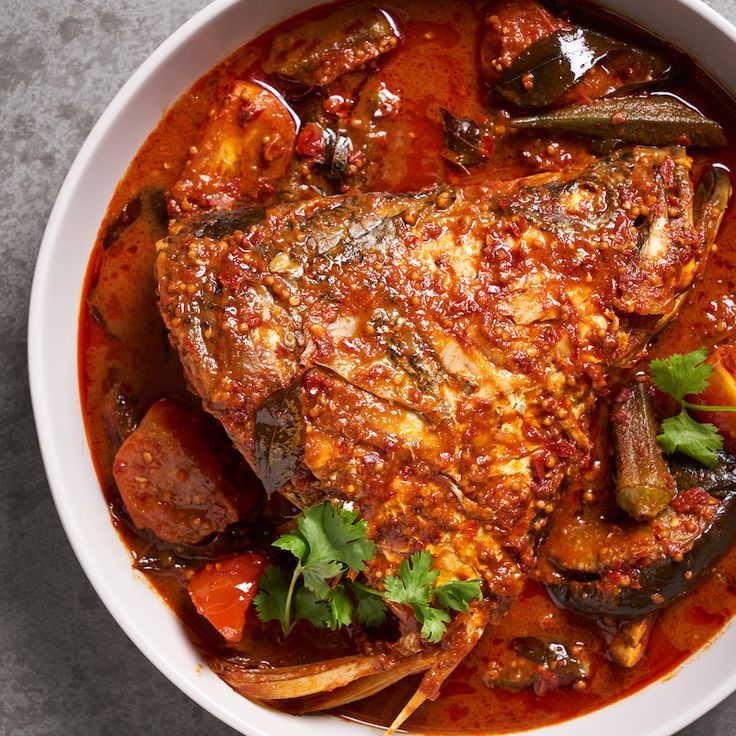
Screenshot of https://www.pinterest.com/pin/554224297906522160/ 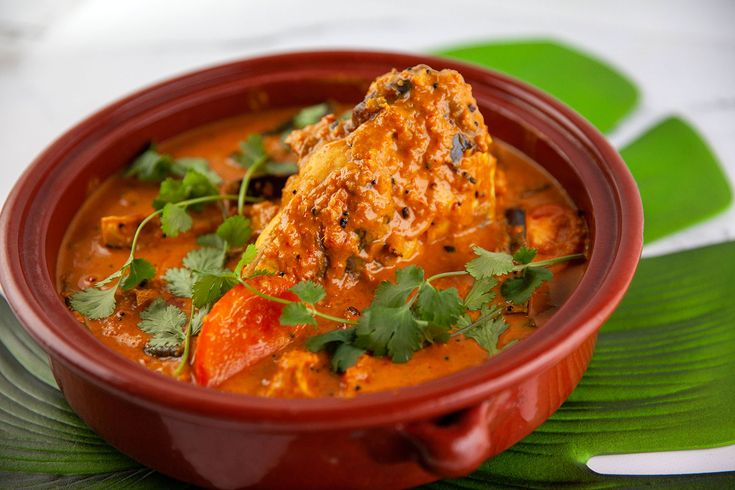
Screenshot of https://www.pinterest.com/pin/118712140168856081/ -
The next street food in Singapore is Roti John. It is thought that Singapore invented the omelet sandwich in the 1960s or 1970s. Later on, it gained enormous popularity and spread as street food throughout the Malay Peninsula in modern-day Malaysia and Indonesia.
Given that the term "John" is widely used in Asia to refer to Caucasians, it is also thought that the dish was developed with Western tastes in mind.
Roti John is essentially a sandwich made with a baguette or French loaf, filled with minced meat (usually beef or chicken) that has been seasoned with various spices and eggs. Roti John is typically cooked on a flat pan, similar to making an omelet. The meat and egg mixture is poured onto the bread and fried until it is golden brown and crispy on the outside.
Today, it has become a beloved staple in the local food scene, with variations including additional ingredients such as onions, chilies, and sauces to spice it up. The combination of flavors in Roti John is truly delightful. The savory meat, the richness of the eggs, and the crunchiness of the bread create a perfect balance of textures and tastes. It is commonly enjoyed as a quick and satisfying meal or a tasty snack.
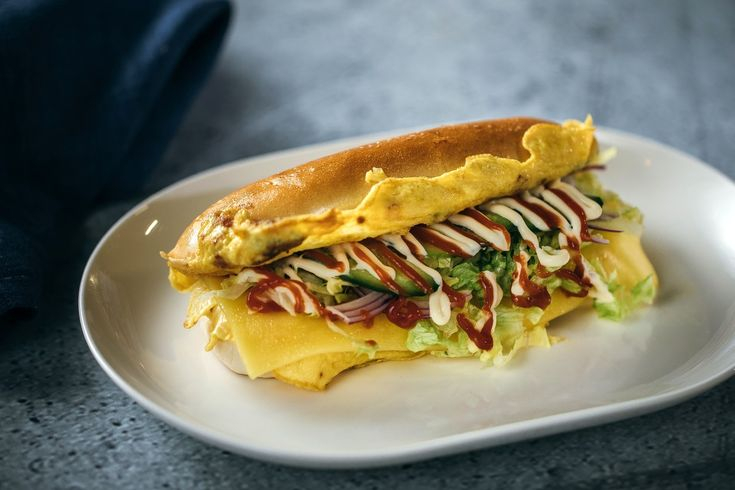
Screenshot of https://www.pinterest.com/pin/828943875177133051/ 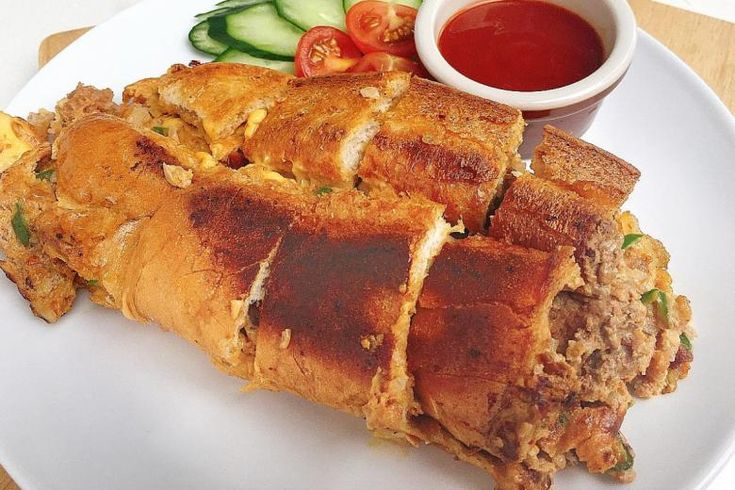
Screenshot of https://www.pinterest.com/pin/735705289129816306/ -
It is one of the most popular breakfast dishes in Singapore. Kaya Toast is a delicious combination of toasted bread, coconut jam, and butter that creates a unique and delightful flavor.
The toast is typically made from soft, white bread, which is then slathered with a generous amount of kaya, a sweet and creamy jam made from coconut milk, eggs, pandan, and sugar. To add an extra touch of richness, a slab of butter is added to the warm toast, melting and mingling with the kaya. The result is a perfect harmony of sweet, aromatic, and buttery flavors that is simply irresistible.
Kaya toast is often enjoyed with a cup of hot aromatic coffee or tea, making it a comforting and satisfying breakfast option for many people in the region. You can easily find Kaya toast on many streets of Singapore. This dish is loved not only because of its attractive flavor but also because of its convenience. You can eat it on the way to school or work.
Kaya toast's preparation process and appearance have evolved. Instead of using conventional charcoal grills, sellers use electric grills. Hawker workers now order their bread supplies from factories instead of making their own. The ingredients and methods may have been simplified, but the kaya spread itself hasn't changed all that much. Reputable stores like Ya Kun Kaya Toast and Killiney Kopitiam still use traditional recipes to make their kaya spreads.Recipes for kaya toast in Singapore:
- Step 1: Grab two pieces of bread.
- Step 2: Slice off the bread's crust.
- Step 3: In your toaster, toast the bread slices until they are golden brown, or perhaps a little darker if you, please.
- Step 4: Distribute the kaya evenly across the toast's two sides.
- Step 5: Cut about four thin slices of cold butter and place them on top of the toast.
- Step 6: Place another piece of toast on top.
- Step 7: You can either cut them into four equal pieces or in half diagonally. When the cold butter comes into contact with the toast's heat, it will gradually melt.
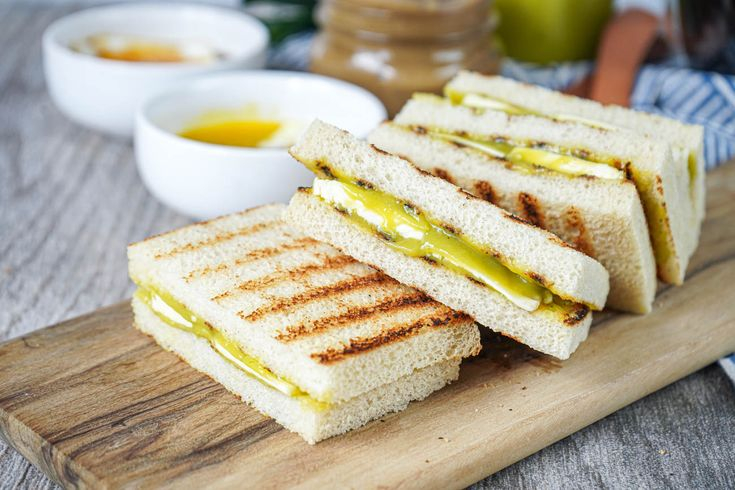
Screenshot of https://www.pinterest.com/pin/607071224793342589/ 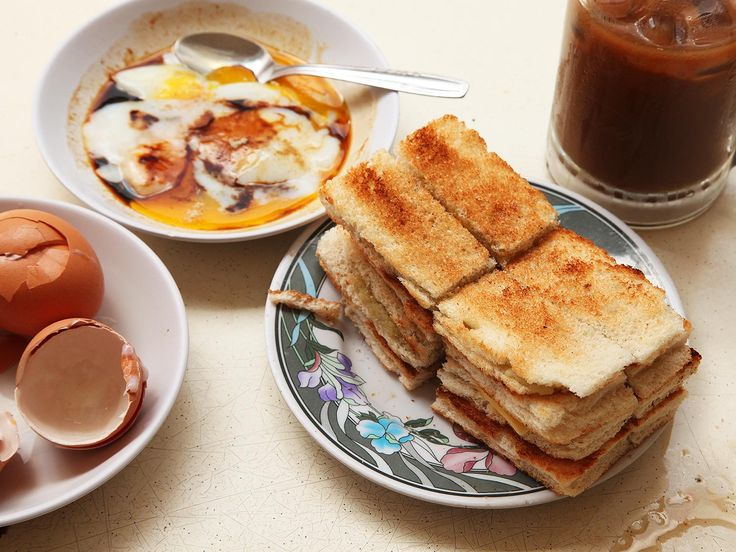
Screenshot of https://www.pinterest.com/pin/643522234276661363/ -
Beef Rendang, a popular dish hailing from Indonesia, has made its way to the culinary scene in Singapore, captivating local food enthusiasts with its rich flavors and tender meat. This slow-cooked delicacy is a must-try for meat lovers looking to indulge their taste buds in a burst of aromatic spices and succulent beef.
In Singapore, Beef Rendang can be found in various hawker centers, streets, and Malay food stalls. The dish showcases a tantalizing medley of ingredients such as coconut milk, lemongrass, galangal, turmeric, garlic, and shallots, all slow-cooked to perfection. The result is a thick and hearty curry with perfectly tender, melt-in-your-mouth beef.
Beef Rendang has intense and bold flavors that develop over the long cooking process. The spices infuse into the meat, creating a harmony of flavors that is both savory and slightly sweet. It pairs wonderfully with steamed rice or even a side of roti prata. It is the explosive flavors that Beef Rendang brings in each piece of meat that has helped it appear on the list of the most popular Singaporean street foods.
Try making Beef rendang at home with the recipe below:
- Step 1: Blend lemongrass, chillies, onions, garlic, ginger, and galangal in a food processor until a fine paste is formed, adjust consistency with a spatula.
- Step 2: In a sizable flameproof casserole, heat the sunflower oil and gently fry the paste for three to four minutes, stirring all the time. Cook the turmeric, coriander, and cumin for two minutes after adding them.
- Step 3: Toss the steak in the paste and spices after adding it to the pan. Cook, stirring constantly, until the meat is very lightly colored all over, about 5 minutes.
- Step 4: Transfer the 400ml/14fl oz of cold water and the coconut milk into the casserole. Simmer after adding the sugar, tamarind paste or lime juice, cinnamon stick, lime leaves, soy sauce, and salt.
- Step 5: Simmer meat and sauce for 2½-3 hours, stirring frequently. Add salt and black pepper to taste.
- Step 6: Transfer the curry into warm serving dishes, garnish with toasted coconut if desired, and remove the lime leaves and cinnamon stick.
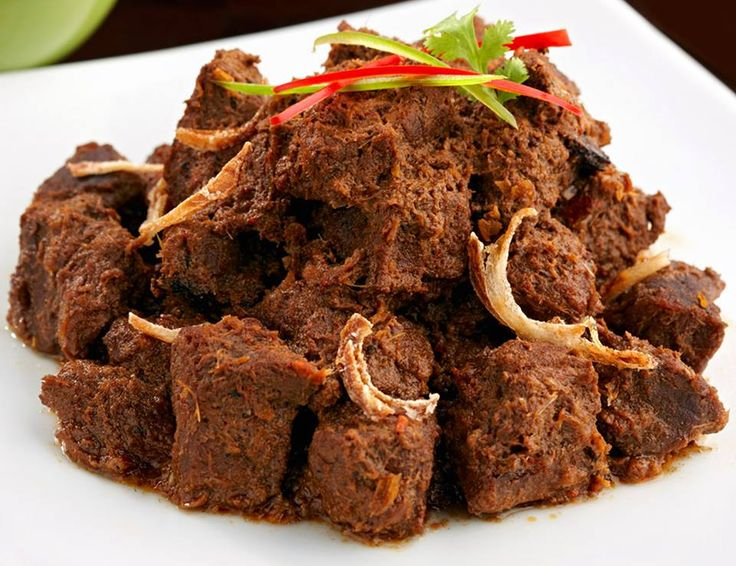
Screenshot of https://www.pinterest.com/pin/467881848763527374/ Video by El Mundo Eats












